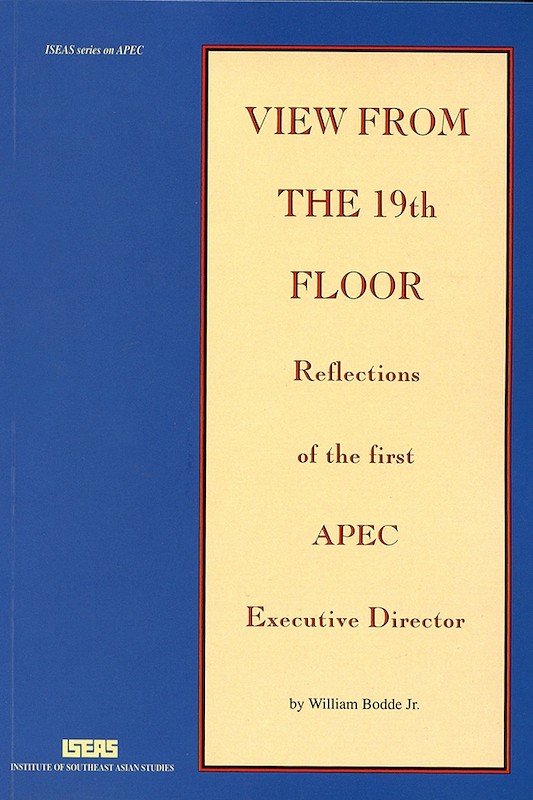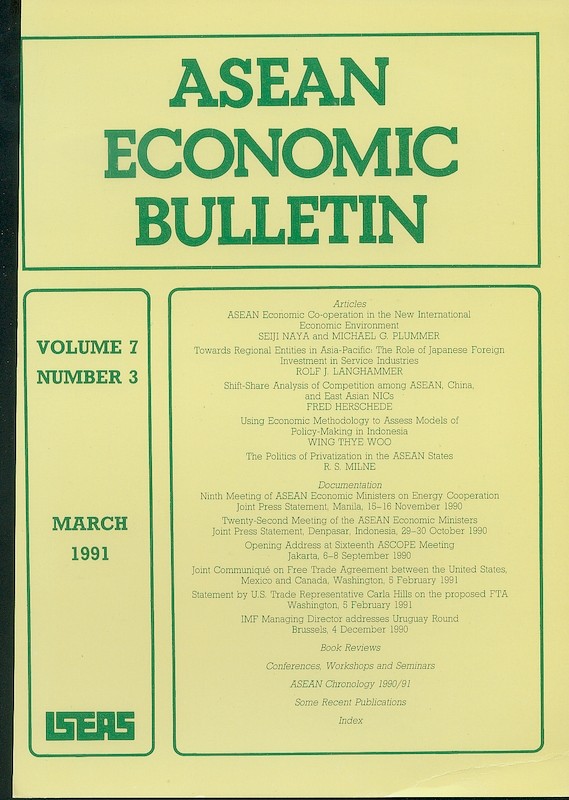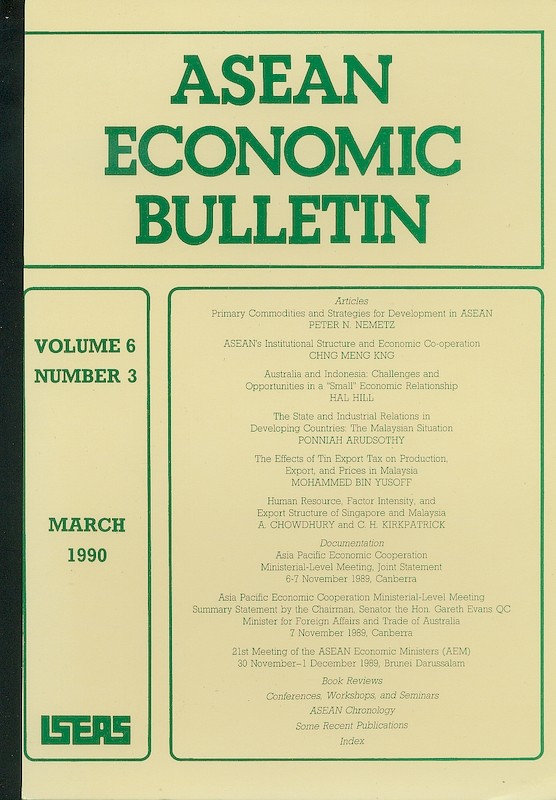ASEAN Economic Bulletin Vol. 10/3 (Mar 1994)

Date of publication:
March 1994
Publisher:
Institute of Southeast Asian Studies
Number of pages:
146
Code:
AE10/3
Contents
-
Preliminary pages
-
APEC: Co-operation amidst Diversity, by Wendy K Dobson, Lee Tsao Yuan, authors see abstractFundamental changes have occurred in the Asia-Pacific region. Not only has the end of the Cold War vitally altered the geopolitical landscape, increasing economic interdependence in the context of rapid economic growth has also changed the nature of relationships among countries. APEC's importance as a regional economic organization can, in part, be viewed as a response to such changes. This article discusses these points in detail. It then offers several scenarios on how APEC is likely to develop in the future.
-
Intersectoral Relationships between Manufacturing and Services: New Evidence from Selected Pacific Basin Countries, by Se-Hark Park, author see abstractThis article examines the nature and the evolution of a symbiotic relationship between manufacturing and services, using input-output tables for selected Pacific Basin countries in two different years, 1975 and 1985. Empirical results seem to suggest, inter alia, that although the service sector bears the brunt of employment generation, its capability to generate and sustain a high level of employment critically hinges upon its vital linkages with the manufacturing sector. Among service inputs to manufacturing, the parallel development of producer services becomes essential to increasing the productivity and competitiveness of the manufacturing sector.
-
Agricultural Diversification: An Overview and Challenges in ASEAN in the 1990s, by Donald C. Taylor, author see abstractIn the 1990s, member countries of the Association of Southeast Asian Nations (ASEAN) are giving special attention to agricultural diversification to (1) facilitate the process of structural transformation in their national economies; (2) overcome low farm income resulting from depressed world prices for rice and other major export commodities; (3) maximize efficiency of resource use; (4) reduce production, price, and income risks; (5) respond to changes in the demand for various agricultural commodities; and (6) reduce ecosystem deterioration. To more fully realize the objectives of diversification, the following challenges must be met: (1) overcome economic disincentives to diversification; (2) improve basic infrastructure to support newly introduced commodities; and (3) find ``middle of the road" government policies on the degree and nature of government intervention, priority to short-term food security versus long term-structural needs, and priority to income distribution versus economic efficiency. Public policy, agribusiness, farmer organizations, and community leaders are encouraged to enter into dialogue to determine how to most appropriately address each of these challenges, including the most satisfactory division of responsibility among various government and private sector bodies to accomplish the strategic tasks.
-
Korea's Direct Foreign Investment in Southeast Asia, by Chung H Lee, author see abstractThis article presents an analysis of the theoretical relationship between a country's economic development and its investment position, and applies it to Korean investment in three industries footwear, apparel, and consumer electronics in Southeast Asia. It is argued that Korean investment was motivated by rapid wage increases at home, substantial currency appreciation, and trade restrictions on its exports in Korea's major trading partner countries. Foreign investment has helped Korean exporters to remain internationally competitive, and the Korean economy has gained by transferring abroad some of its labour-intensive industries in which it was losing its comparative advantage. Korean investment in Southeast Asia has had the beneficial effect of creating employment in the host countries. However, it has had little linkage effect since must of the machinery and equipment as well as materials and parts were brought over from Korea. Also, there seems to have been little transfer of technology to the host countries. It is, however, expected that with time linkages will develop and technologies and know-how will be transferred to the host countries.
-
Gradual Financial Reform in Action: The Case of Thailand, 197992, by Daniel Lian Choon Beng, author see abstractThe rapid growth of the Thai economy in recent years was marked by vigorous pursuit of real reforms and gradual financial liberalizations. The reasons for gradual rather than sweeping financial reform were: the non-existence of a financial development model; strong state presence in the financial system and the need to manipulate the system to finance both government deficit and priority sectors; structural and macroeconomic difficulties associated with sweeping reform; and an oligopolistic banking system and its concomitant political power. In general, the reform was slower in the initial years (1979--86) to allow for structural adjustments so to avoid macroeconomic difficulties. Reform shifted into higher gear as the real economy expanded vibrantly from 1987. This article analyses and documents the gradual reforms by subsectors from the perspective of policy measures. Quantitative evidence demonstrates that policy reforms yielded robust financial development.
-
Australia's Aid Motives to Near Neighbours: Southeast Asia and the South Pacific, by Rukmani Gounder, author see abstractThis study focuses on the literature of aid motives of donor nations. After providing a brief overview of the aid motivation literature, which emphasizes two competing models of recipient need and donor interest, the article estimates these two models on the data for Australian bilateral aid. The models are estimated on data for recipient countries in Southeast Asia and the South Pacific. Unlike previous empirical studies (relating to superpowers), this study shows that both the recipient need and donor interest models fit Australian bilateral aid.
-
DOCUMENTATION: Joint Press Statement of the 25th Meeting of the ASEAN Economic Ministers, Singapore, 7-8 October 1993.
-
DOCUMENTATION: Keynote Address by Mr Goh Chok Tong, Prime Minister of Singapore at the 25th ASEAN Economic Ministers' Meeting, Singapore, 7 October 1993
-
DOCUMENTATION: Joint Statement at the Asia-Pacific Economic Co-operation Ministerial Meeting, Seattle, Washington, 17-19 November 1993.
-
DOCUMENTATION: APEC Leaders Economic Vision Statement, Seattle, Washington, 20 November 1993
-
DOCUMENTATION: Declaration of APEC Ministers on the Uruguay Round, Seattle, Washington, 20 November 1993
-
DOCUMENTATION: Statement of APEC Members Participating in the Uruguay Round, Seattle, Washington, 20 November 1993
-
BOOK REVIEW: Pacific Dynamism and the International Economic System, edited by C Fred Bergsten and Marcus Noland, by Ozay Mehmet, author
-
BOOK REVIEW: Open Regionalism? NAFTA, CER and a Pacific Basin Initiative, by Sir Frank Holmes and Crawford Falconer, by Robert L Curry, Jr., author
-
BOOK REVIEW: Economic Stabilization in Developing Countries, by Richard N Cooper, by Hans C Blomqvist, author
-
BOOK REVIEW: Nusa Tenggara Timur: The Challenges of Development, edited by Colin Barlow, Alex Bellis and Kate Andrews, by Geoffrey B Hainsworth, author
-
Conferences, Workshops and Seminars
-
ASEAN Chronology 1993-94
-
Some Recent Publications
-
Index to Volume 10



